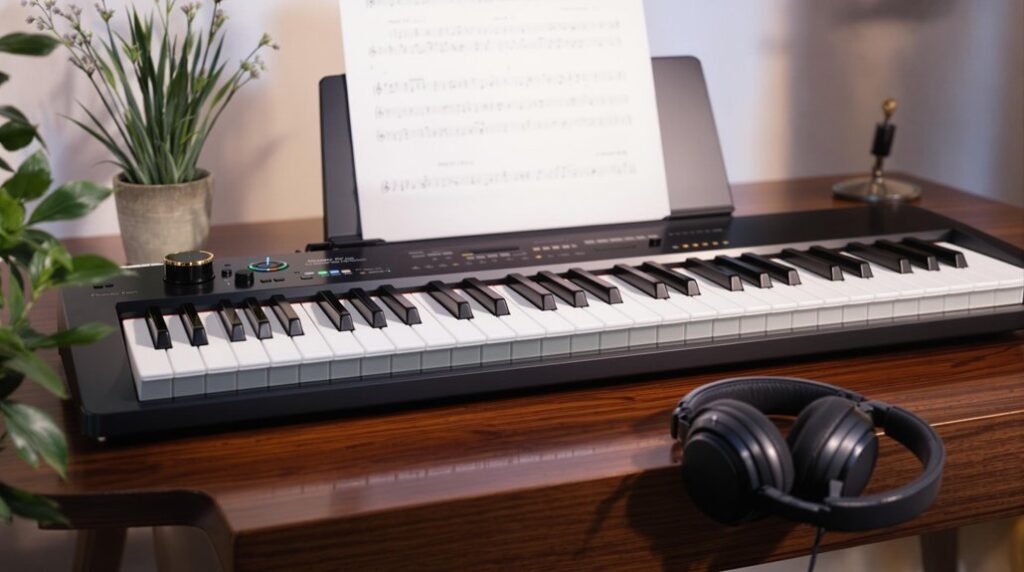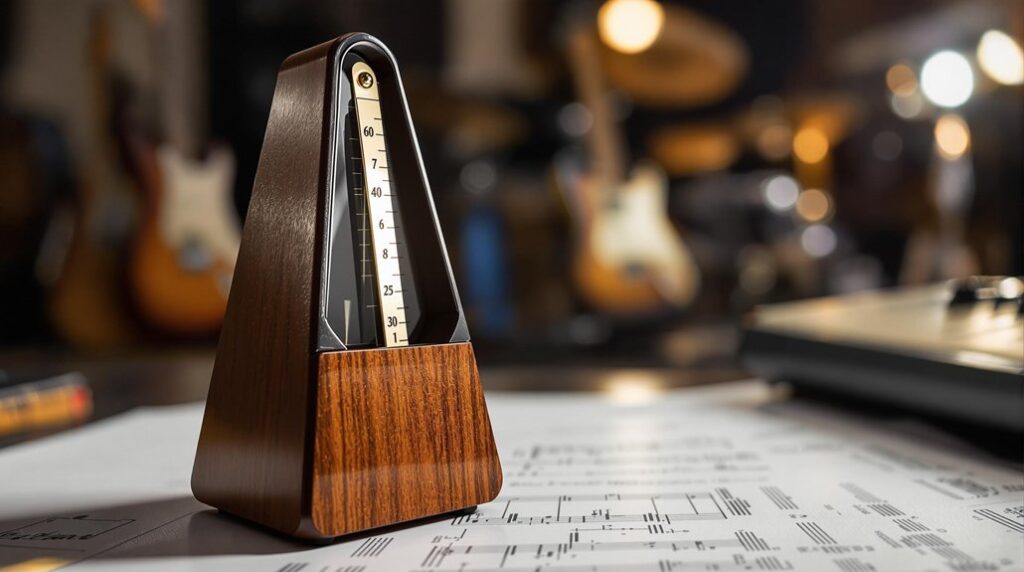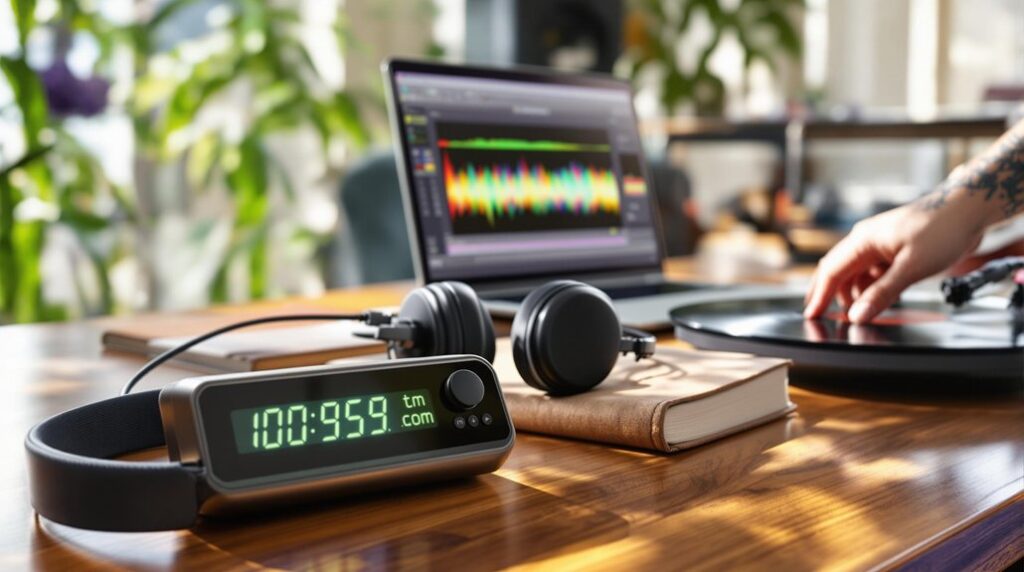For beginner DJs, grasping music theory is the key to creating compelling sets. Understand rhythm by mastering the 4/4 time signature and aligning tracks by BPM for smooth shifts. Immerse yourself in the world of notes, keys, and scales, where major and minor keys set emotional tones and scales allow seamless track blending. Chords add harmonic depth, with melodies and passing tones crafting memorable hooks. Build a dynamic library with frequent updates and explore DJ pools for exclusive tracks. Learning is endless; from video tutorials to tailored courses, each step enriches your musical journey and opens new creative avenues.
Key Takeaways
- Understand music theory fundamentals for improved harmonic mixing and seamless DJ set transitions.
- Master rhythm and timing by aligning tracks with BPM and maintaining cohesive mood-aligned sets.
- Familiarize yourself with notes, keys, scales, and chords to enhance emotional tone in mixes.
- Utilize DJ pools to access exclusive tracks, support artists, and expand your musical repertoire.
- Continuously research new music trends and utilize educational resources to deepen DJ skills and creativity.
Importance of Music Theory
A fundamental understanding of music theory is invaluable in the field of DJing, serving as a critical bridge between technical skill and creative expression.
For the beginner DJ, mastering music theory’s importance cannot be overstated. It empowers them with harmonic mixing capabilities, turning sets into seamless narratives. The comprehension of key and scale enhances mixes, offering smoother shifts and a unique sound signature.
This theoretical foundation enriches the understanding of rhythm, enhancing the DJ’s ability to craft engaging performances. Additionally, music theory knowledge facilitates communication with fellow DJs and musicians, fostering collaboration.
As the building blocks of music become second nature, DJs can explore deeper into software features and music production, revealing endless creative possibilities and pushing artistic boundaries. Moreover, a solid grasp of common song structures can help DJs create more engaging transitions during live sets.
Mastering Rhythm and Timing
Building upon the foundational pillars of music theory, mastering rhythm and timing is where a DJ’s technical prowess truly shines. At its core, music is structured in bars, often with a 4/4 time signature, allowing DJs to count beats effectively. Understanding the concept of “on the one” is vital for identifying the first beat of each bar, ensuring that shifts are seamless and precise. By aligning tracks based on beats per minute (BPM) and practicing rhythmic counting, DJs can execute effective mixing techniques. Familiarity with beat types—straight, swing, and Latin—adds versatility, while music theory concepts like whole notes and half notes solidify timing skills. This rhythmic mastery is essential for enthralling audiences and delivering unforgettable performances. Additionally, knowledge of time signatures provides a framework for exploring complex rhythms and enhancing overall musical expression.
Notes, Keys, and Scales
Revealing the essence of DJ artistry begins with a firm grasp of musical pitch, where the tapestry of sound is woven from 12 unique notes, each a step in the cyclical dance of octaves.
Recognizing key structures is akin to deciphering the language of harmony, where every key governs a set of notes that whisper tales of joy or melancholy. Understanding these core concepts of music theory will empower you to create more engaging and emotionally resonant mixes.
Understanding Musical Pitch
In the sphere of Western music, the concept of musical pitch is a cornerstone for understanding the intricate dance between melody and harmony. With only 12 unique notes forming the backbone of any music library, DJs must master the art of understanding musical pitch.
Each note, from A to G, weaves into the fabric of major and minor keys and scales, providing the framework for analysing melodies. The C major scale, for instance, reveals a cheerful cadence, while its minor counterpart casts a more somber tone, creating dynamic contrasts.
Recognizing how these notes interact within their scales and keys allows DJs to seamlessly blend tracks, aligning beats per minute (BPM) to craft a harmonious auditory tapestry.
Recognizing Key Structures
Having grasped the importance of pitch, the next step in mastering DJ music theory lies in recognizing the intricate structures of notes, keys, and scales.
In Western music, twelve unique notes—A through G, including sharps and flats—form the foundation of melodies and harmonies. A key, such as C major, harmonizes a selection of notes like C, D, E, F, G, A, and B, creating a soundscape ripe for exploration.
Scales, the sequential journey through these keys, reveal the musical terrain. Major chords, joyous and vibrant, emerge from the first, third, and fifth notes of a major scale, while minor chords whisper melancholic tales.
Melodies weave above, crafting emotional tapestries, intertwining with chords to create resonant, unforgettable tracks.
Understanding Chords and Melodies
Delving into the intricate world of chords and melodies reveals the foundational essence of music’s emotional language. Chords, constructed from triads, underpin songs with harmonic depth. Major chords exude brightness through a four-key interval followed by three, while minor chords impart somber tones with the reverse.
Melodies, the single-note sequences weaving over chords, capture attention, often climbing to higher pitches to enhance interest. Passing tones—extra notes bridging chords—enrich the musical narrative, crafting hooks that captivate.
For DJs, mastering the synergy between chords and melodies is pivotal; they form the core of memorable hooks and shifts that define a set’s ebb and flow. Understanding this interplay breathes life into tracks, making them resonate with listeners on a profound level. Additionally, the use of chord progressions can significantly enhance emotional impact, guiding listeners through a sonic journey.
Educational Resources for DJs
For aspiring DJs enthusiastic to fine-tune their craft, video tutorials and structured courses offer a symphony of learning opportunities. Platforms like Digital DJ Tips amplify skills through immersive visuals, while Club Ready DJ School orchestrates a curriculum tailored to reveal the nuances of music theory. Additionally, exploring comprehensive tutorials can provide valuable insights into mixing techniques and sound design that enhance a DJ’s performance.
Video Tutorial Recommendations
When commencing the journey to master DJ music theory, the wealth of video tutorials available online serves as an invaluable resource for beginners enthusiastic to hone their craft. Channels like Club Ready DJ School offer foundational lessons, guiding through the learning process with ease. Investigate specific DJ course videos to explore features of controllers like the Pioneer DDJ-FLX4, ensuring a hands-on understanding essential for practice beatmatching. These resources provide important DJ Tips, enriching your electronic music skills.
| Resource | Focus Area |
|---|---|
| Club Ready DJ School | Foundational DJ Techniques, Music Theory |
| Pioneer Controller Tutorials | Features, Practical Mixing, Beatmatching |
| Live Streams from DJs | Real-time Music Theory Application |
Structured Course Options
A multitude of structured course options awaits aspiring DJs, offering a pathway to mastering both technical skills and music theory essentials.
Platforms like Club Ready Courses unfold a thorough learning journey, intertwining essential DJing techniques with music theory fundamentals. These structured courses explore the intricacies of beatmatching and harmonic mixing, transforming complex concepts into digestible tutorials.
Free and paid resources cater to various DJ controllers, empowering beginners to swiftly navigate their equipment. Engaging with events and live streams enriches practical skills, while providing real-time feedback from seasoned professionals.
Beyond technical mastery, these courses cultivate networking opportunities, connecting learners with peers and mentors vital for growth within the DJ community. Such educational ventures are a symphony of learning and connection.
Building a Music Library
Crafting a dynamic music library is the beating heart of any DJ’s craft, providing the foundation for unforgettable performances. For the Digital DJ, building a music library is an art form. Embrace DJ pools like Beatport and DJ City to access tracks with extended intros and outros, enhancing beats per minute (BPM) shifts. In Music Theory For DJs, curating a collection of 20 mood-aligned songs guarantees a cohesive set flow. Regularly research fresh tracks to keep audiences engaged. Purchase music to support artists and assure reliability during events. Additionally, consider a well-rounded music library to ensure your sets resonate with diverse audiences.
| Source | Feature | Benefit |
|---|---|---|
| DJ Pools | Extended Intros/Outros | Smooth Mixing Shifts |
| Own Music | Purchased Tracks | Reliability & Artist Support |
| Curated Set | Mood-Aligned Collection | Cohesive Flow |
Backup your library to safeguard your musical arsenal.
Frequently Asked Questions
Do You Need to Know Music Theory to DJ?
While not essential, understanding music fundamentals enriches a DJ’s craft. Mastery of beat matching, song structure, harmonic mixing, rhythm patterns, and audio effects empowers DJs to create dynamic sets, enhancing both artistic expression and audience engagement.
What Do I Need to Know Before Starting DJ?
To start DJing, understand your DJ gear and music genres. Master beat matching and mixing techniques. Choose appropriate software for seamless changes. Prioritize crowd interaction to enhance atmosphere and boost performance, ensuring a engaging and dynamic experience.
What Are the Basics of Music for DJ?
Understanding music basics for DJs involves mastering beat matching and song structure, recognizing tempo variations, and key signatures. This knowledge aids in blending musical genres through creative mixing techniques, ensuring seamless shifts and dynamic performances.
How to Learn DJ Mixing for Beginners?
Aspiring DJs should focus on mastering beat matching and handling tempo changes. Prioritize track selection and refine EQ adjustments. Employ diverse mixing techniques to craft creative shifts, ensuring smooth and dynamic sets that captivate audiences.
Conclusion
In summation, an in-depth comprehension of music theory fundamentals equips DJs with the tools necessary to craft seamless and engaging performances. Mastery of rhythm and timing, alongside a thorough understanding of notes, keys, scales, chords, and melodies, forms the backbone of musical expertise. Utilizing educational resources enhances this knowledge, while a meticulously curated music library serves as an essential asset. These elements together foster creativity, technical precision, and an enriched auditory experience for audiences.




